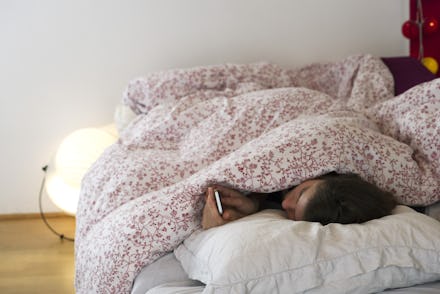Your Phone Could Actually Make You Get Off Your Ass Once in a While

Cellphones get a bad rap for encouraging screen addiction and couch potato behavior, but a new study suggests that your smartphone could, in fact, make you more active.
Researchers observed the sedentary behavior patterns of 215 people and compared those who received "mobile phone intervention" — alerts telling them to get up and move — with those who did not.
At the end of a seven-day period, those who received the alerts clocked in 3% less sedentary time than those who did not. In measurable terms, this translated to about 25 minutes of active behavior rather than sedentary behavior.
Given the wealth of research that has been done on the ill effects of sedentary behavior — greater chances of heart problems, obesity and diabetes, to name a few — this new research, published in the Journal of Medical Internet Research, may come as a welcome sign for those looking for new ways to combat too-much-sitting syndrome.
"We tend to carry our smartphones with us wherever we go. A smartphone prompt can alert us to our sedentary behavior," the study's lead author, Darla Kendzor, told Mic in an email. "If our smartphones can reach us in so many places, perhaps we can begin to make more comprehensive changes to our lifestyles."
The study: Kendzor and her colleagues studied the behavior patterns of a control group, made up of 120 participants, and an "intervention" group, which had 95 participants. Each group wore an accelerometer — a device used to measure acceleration — and was asked to complete smartphone-based reports on their daily activity.
The intervention group, however, differed in three ways: They were given a brief handout warning them of the negative effects of sedentary behavior; they received smartphone alerts if they clocked more than two hours of sitting during the day before; and they received alerts if they they were sedentary during randomly assigned check-ins, which occurred four times per day.
The message alerts, adapted from previous research, looked like this:
Medical research has shown that long periods of uninterrupted sitting increase the likelihood of several health problems, including obesity and Type 2 diabetes. Make an effort to stand up more, sit less and move about more. This can be achieved by taking frequent standing and walking breaks (at least one break for every half-hour of sitting); standing up when talking on the phone (at work or home), checking emails, etc.; and replacing blocks of sitting time with standing time, such as doing household chores while watching TV.
"It is easy to imagine that smartphones could be used to intervene on the most common and problematic health concerns including smoking, obesity, inadequate physical activity, medication adherence and numerous others," Kendzor told Mic.
Kendzor also added that the study's sample size was a limitation for researchers. "Future work will incorporate a larger sample as well as randomization," she noted. "We are also working on developing a more sophisticated app that will prompt individuals to get up and move around based on real-time monitoring of sedentary behavior via a wearable device."
Encouragingly, this study also backs up past research examining the relationship between smartphones and physical activity. As Mic reported in September, another study showed that people who used fitness apps were more active than those who didn't.
Sedentary lifestyles are a common problem in the United States — studies have estimated that we spend roughly eight hours a day sitting — but given how common smartphone use is, alerts like those used in the study may be a way to circumvent sitting woes.
Still, Kendzor cautioned that consumers need to be careful before they begin relying on apps for their fitness.
"Many health-related apps are already out there, but it is important that we evaluate the effectiveness of these apps before they are recommended and offered by public health experts as effective intervention tools," she told Mic.
h/t Live Science